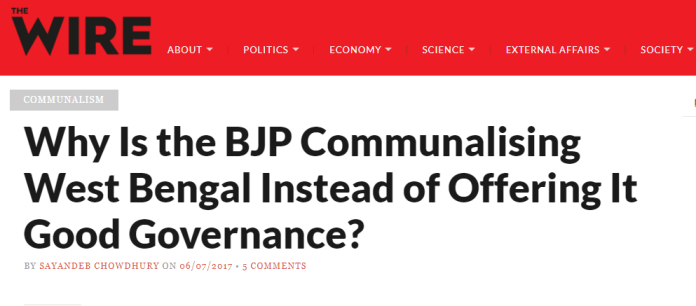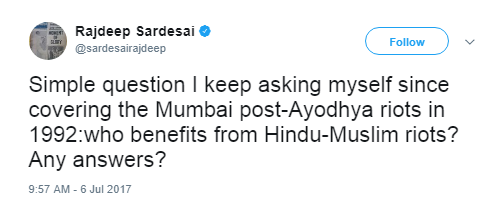Yesterday the country witnessed a barbaric attack on Hindu pilgrims who were returning after taking Darshan at the holy Amarnath temple in Kashmir. At about 8:30 PM on Monday, as a bus carrying 60 Amarnath Pilgrims was returning to Jammu, terrorists opened fire at it. This led to the death of 7 pilgirms including 6 women and injured 19 more.
It is believed that 3-5 Pakistan backed terrorists led by one Ismael belonging to the Lashkar-e-Taiba carried out the attack. The casualties could have been more, but according to a passenger on that bus, the driver heroically drove through a hail of bullets to ensure that the bus reached to safety.
This attack shocked the nation. While most were demanding retributive justice and accountability from the government, there were few politicians and media persons who shamelessly tried to politicise the gruesome murder to peddle their agenda:
Last killing of pilgrims in terror attack was in 2000, under BJP-led NDA. Now, again in 2017. How did the situation in Kashmir come to this?
— Sitaram Yechury (@SitaramYechury) July 10, 2017
The CPM leader whose party in Kerala allows murders of RSS workers to go on unabated, was slammed for his comment. He also conveniently forgot that pilgrims were attacked in 2006 and 2007, when his party had extended support to the UPA government:
It proves that you fund terrorists to kill Hindus when BJP is in power. https://t.co/3KEFw8YCt7
— Neta Ji (@AapGhumaKeLeLo) July 10, 2017
You forgot to mention 9/11 attacks that killed more than 5K people happened in 2001, also under the BJP-led NDA https://t.co/TiE4yixXju
— Ra_Bies (@Ra_Bies) July 10, 2017
AAP MLA Alka Lamba, who in the past had laughed about her delaying a fire rescue operation, decided to peddle a cringeworthy conspiracy theory. She was widely slammed for this comment, following which she deleted the tweet:
Even 100 morons can’t equal 1 AAPtard! pic.twitter.com/7ke5JVY1ll
— Keh Ke Peheno (@coolfunnytshirt) July 10, 2017
Reason why I left supporting AAP & would prefer burning my voter ID card over voting for them. pic.twitter.com/bmBuotEepY
— Smoking Skills (@SmokingSkills_) July 10, 2017
Modi hating ex-cop, who regularly spreads anti-India propaganda, also joined in spreading the conspiracy theory, which was shared widely by Pakistanis and anti-Hindu commentators, as generally happens with his tweets:
Al the Yatris killed in the Anantnag attack were from Gujarat. Double whammy for BJP in view of the forthcoming Gujarat Elections? Cui bono?
— Sanjiv Bhatt (IPS) (@sanjivbhatt) July 10, 2017
Can this even more be disgusting? Such display of pathological hatred. https://t.co/ygu6rbim4l
— SG Suryah (@SuryahSG) July 10, 2017
Even journalists didn’t want to be left behind. A comment by controversial journalist Barkha Dutt, suggesting that the Yatra should have been suspended this year, was slammed as being akin to ‘victim blaming’:
Don’t draw cartoons, you’re asking for it. Don’t wear short clothes, you’re asking for it. Don’t conduct yatra, you’re asking for it. https://t.co/eyPqAct03v
— Hardik Rajgor (@Hardism) July 10, 2017
How different is this statement from telling women to stay inside homes because rapists are out there in the society? https://t.co/1wWTc2wCb0
— Monica (@TrulyMonica) July 10, 2017
One so-called journalist, with a history of peddling unsubstantiated claims, subtly painted the attackers as ‘militants’:
Amarnath attack is the most cowardly act that militants could get to. What a shame. Kashmir, this cannot happen in your name. DISGUST
— Rana Ayyub (@RanaAyyub) July 10, 2017
Goldmine of hypocrisy this tweet. Choice of words! https://t.co/uELCOuLKyn
— Sujoy (@CW_dynastycrook) July 10, 2017
See how easily the word terrorist is used by this terror apologist bigot when it comes to Hindus, while for her ilk it becomes militants pic.twitter.com/IayhfiMCoD
— The Masakadzas (@Nesenag) July 10, 2017
Some where more concerned about ‘Kashmiri Suffering’ than hate crime against Hindus, such as senior journalist Shekhar Gupta of ‘coup’ fame:
What kind of “holy” fighters kill simple pilgrims. They may take some innocent lives but will kill residual sympathy for Kashmiri suffering
— Shekhar Gupta (@ShekharGupta) July 10, 2017
In Bengal, the real concern is “BJP may win”. In Kashmir, the real concern is “Kashmiri suffering”. Deep seated Hinduphobia is okay. https://t.co/ysUD38pHW9
— Rahul Roushan (@rahulroushan) July 10, 2017
Killing pilgrims is not bad as long as it doesn’t affect the perception of Kashmiri sufferinghttps://t.co/r1qAzYMpzo
— दिव्या (@divya_16_) July 10, 2017

























